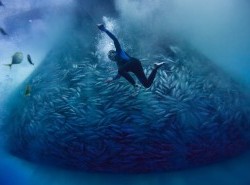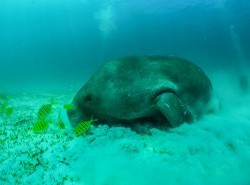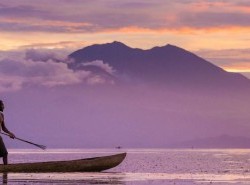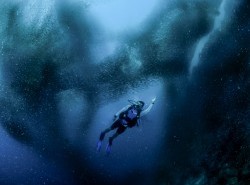The so called Twilight Zone - between 60 & 150 metres - is one of the least explored areas of the ocean. A recent research trip by the California Academy of Sciences to the Philippines reveals its unique reef systems are home to many as yet undiscovered species - and sadly pollution too.
A Blue Ringed Octopus at 90 metres
The California Academy of Sciences’ Hope for Reefs initiative is an ambitious project aimed at advancing coral reef science through a series of trailblazing expeditions. The mission to explore the so called "Twilight Zone" regions of the world's oceans is among their most exciting projects - shedding light on one of the least known marine ecosystems out there. Their most recent research trip to the Philippines targeted one of the most abundantly diverse areas of the Coral Triangle - what they discovered was both wondrous and sobering...
A Cup Coral at 130 metres
The Verde Island Passage in the Philippines has been a longtime regional focus of Academy research considered the “centre of the centre” of marine biodiversity by its scientists. The Academy’s science diving teams explored both deep and shallow ecosystems to document species richness, evaluate ecosystem health, and gather data to support smarter ocean conservation strategies.
A Slopefish (Symphysandodon) at 130 metres
Building upon nearly three decades of Academy research in the region, the team has once again discovered several new species of fish, nudibranchs, urchins, and sand dollars. Academy researchers have visited the region since 1992 and in that time have discovered over one thousand species that are new to science. This most recent expedition proved extremely fruitful in terms of new species also.
A beer can at 120 metres
But as well as discovering new marine species, the deep-diving “twilight zone” team also documented shocking evidence of human impacts between 60 & 150 metres below the ocean’s surface, indicating that mesophotic deep reefs are just as heavily impacted as their shallow counterparts. Because they're out of reach to most divers, these impacts are rarely noticed or reported. Protecting them should be a major priority - but for now, these areas are largely ignored by current protections.
Blotched Anthias (Odontanthias Borbonius) at 120 metres
Marine protected areas (MPAs) and sanctuaries tend to favor shallow reefs better known to science and coastal communities.
Two little Red Striped Anthiases (Pseudanthias Fasciatus) at 90 metres
Coral reefs are some of the most beautiful, biologically diverse, and economically valuable ecosystems on Earth. They cover less than 1% of the ocean but contain more than 25% of all marine species. The Coral Triangle is the epicentre of coral reef biodiversity on the planet Coral reefs here and indeed globally are integral to the livelihoods and well-being of billions of people, providing protection from erosion and storm damage, and generating income through ecotourism and fishing.
An urchin...caught on a fishing line at 100 metres
But nearly 75% of the world’s coral reefs are currently threatened by the combined impacts of overfishing, habitat destruction, water pollution, climate change, and ocean acidification.
A scorpion fish at 140 metres
The California Academy of Sciences' Hope for Reefs initiative is one of the projects that is working hard to reverse the potential collapse of global coral reefs by exploring little-known ecosystems and advancing coral reef science by decades and communicating the importance of coral reefs and the threats they face to as wide an audience as possible.
A new species of Sand Perch! (Parapercis) at 100 metres










